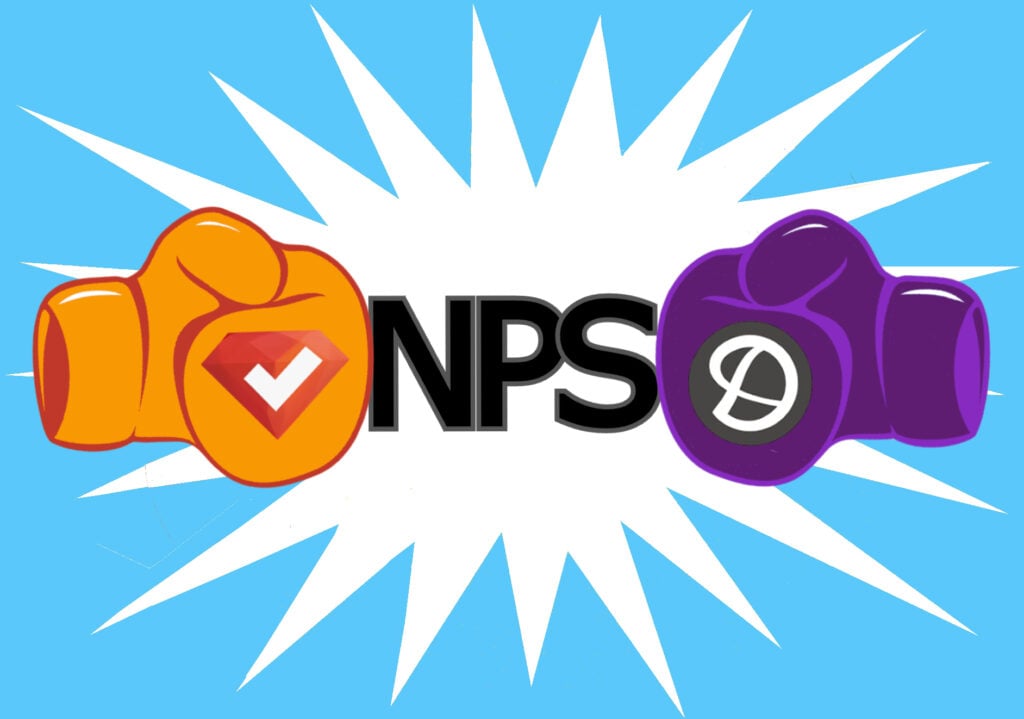How likely are you to recommend us to a friend or colleague? You’ve certainly seen that question before on a survey. It’s a prime example of an NPS question. Today, more and more companies are using NPS to gauge how well they’re meeting customer expectations. In this blog, we’ll look at the importance of NPS scores and how to calculate NPS.
What is the NPS and Why Is it Important?
A Net Promoter Score (NPS) is a metric used in customer experience programs. To arrive at an NPS, surveys will ask customers various questions about their experience with a company, product, or service. Respondents select their level of satisfaction (or another metric) on a scale of one to ten.
NPS is important because the data helps companies gauge the quality of their customer service, especially in relation to their competitors. NPS gives businesses the information they need to improve the customer experience, fix any problem areas, monitor loyalty trends, and grow revenue through referrals and upsells. The higher the NPS, the more loyal customers and enthusiastic brand advocates a company has.
Read about 15 NPS Best Practices You Need to Know.
How to Calculate NPS
So what is the net promoter score formula? Before we get to that, you need to understand the different categories of respondents. They are broken into three categories based upon how they scored questions, as follows:
- Promoters (score of 9 and 10). These are your most satisfied customers and the ones most likely to become brand advocates, referring your product or service to others.
- Passives (score of 7 and 8). These customers are generally satisfied, but they’re not going to go out of their way to promote your product or service. The good news is they also won’t speak negatively about their experience, either.
- Detractors (score of 0 to 6). At best, these customers probably won’t purchase your products or services again; at worst, they may actively bad-mouth your company or brand, damaging your revenue and reputation.
Okay, now you’re ready to get your NPS calculation. To calculate NPS, simply subtract the percentage of detractors from the percentage of promoters (because passives are considered “indifferent,” they are not included in the NPS formula).
 Ready to get started? Use our free NPS template!
Ready to get started? Use our free NPS template!
Here’s an NPS example. Let’s say 20% of respondents are detractors, 10% are passives, and 70% are promoters. Your NPS formula would be 70-20=50.
Your NPS score can range from -100 to 100, with 100 being ideal. Of course, while every company should strive to hit 100, it’s very hard to do – it would mean 100% of your customers are promoters. However, by understanding your net promoter score, and the kinds of customers that fit into each group, you’ll be able to take the actions needed to turn detractors into promoters.
Calculated your NPS and unhappy with it? Check out our blog How to Improve Your NPS in 8 Easy Steps.
How SurveyLegend Calculates NPS For You
Not a numbers person? SurveyLegend automatically calculates NPS for you. Just log in to your account to see your score, and watch it change as more survey data comes rolling in.
SurveyLegend offers two types of diagrams to visualize your NPS Score: NPS Bar Charts and NPS Gauge. Visualizing your NPS data empowers you to begin making business decisions that can improve your score – or if you’ve got a great score, continue to maintain it.
Learn more about using NPS analytics in our blog How to Use NPS Data to Improve the Customer Experience.
What to Do with Your NPS Data
Once you’ve collected NPS data and have your score, you’ll want to continue to closely monitor your NPS. If you have a good score, you’ll want to be sure you maintain it. If you had a poor score, you’ll want to make improvements and see if it increases. Along with monitoring your NPS, you’ll also want to continue to engage with respondents. Start by thanking them, regardless of how they responded. Consider the following:
- Promoters. Let them know that you appreciate their positive response and will continue to meet or exceed their expectations. You might even send them a coupon code or similar as a thank you to push them toward brand advocacy.
- Passives. Let them know you’ll do better in the future to keep them as a customer. You might consider a thank you offer to help push them from passive to promoter.
- Detractors. Let them know you’ll work to resolve their issues (and then make good on that promise). While you likely won’t convert them to passive or promoter, this can stop them from actively speaking negatively about your company with others or on social media.
NPS Questions for Follow-up
You should also consider follow-up questions. It’s important to understand why someone responded positively or negatively. A few follow-up questions to consider include:
Promoters: Questions to ask following an NPS survey may include:
- What is the primary reason for your score?
- Tell us what did we do best during your experience.
- How can we do more to wow next time?
Passives: Questions to ask following an NPS survey may include:
- What is the primary reason for your score?
- Did you encounter any particular issues?
- What is one thing we could do better to meet your expectations?
Detractors: Questions to ask following an NPS survey may include:
- Why would you not recommend us?
- What could we have done to improve your experience?
- Would you consider us again if your suggestions were instituted?
Conclusion
Knowing your NPS is critical. It helps you understand what you’re doing right – and what you can do better. It also helps you understand your customers so that you can keep promoters, persuade passives, and pacify detractors. And while calculating NPS isn’t difficult, it can become daunting when you’re dealing with hundreds or even thousands of surveys. That’s why SurveyLegend does the NPS computation for you! That’s not all, our surveys render beautifully on any device, and give you the option to add survey images to further engage respondents!
Get started with SurveyLegend today – and let us do the NPS calculations for you! For more, check out our Ultimate Guide to NPS and NPS Surveys.
Do you know your NPS? Did you do your own NPS calculation? Have you used surveys to better understand your NPS? Let us know in the comments!
Frequently Asked Questions (FAQs)
NPS stands for Net Promoter Score. It was created by Fred Reichheld, a partner at Bain & Company, in 2003. He developed the NPS as a way of measuring how well an organization treats customers and whether it generates customer loyalty.
The NPS formula is Total Promoter Score – Total Detractor Score = NPS. Passives are not included in the NPS computation.
An NPS of 0 is considered good. An NPS above 20 is great and an NPS of 50 or above is excellent. At 80, an NPS is considered “world-class.” The best NPS is of course 100, although that is extremely difficult to achieve as it would mean that every customer is a promoter of a particular company or brand.






